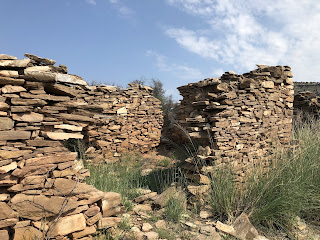I cannot tell you the name of this most excellent ghost-town because it's on private property, and I may or may not have ventured there unbeknownst to the owner. Now, hear me well! The editorial board of Snow and Jaggers in no-wise encourages or condones trespassing. But this area--although fenced for cattle--was not posted. So it's officially a gray area. Plus, this place has been on my ghost-town wishlist for DECADES, and it always appeared very unwelcoming in the past. Just incidentally, the maximum punishment for trespassing in New Mexico is a $1,000 fine.
Of course, if I had trespassed in this beautiful place, I'd have done it respectfully and even reverently, taking great care to leave this venerable old Spanish settlement exactly as I found it. Here's the mostly dry bed of Trementina Creek as it passes between cottonwoods through the dusty town site.
A view from the inside of a ruined house.
A very large house in the town. It looked as if rooms were added slowly as adult children got married and brought their own families under the roof to live.
Look at the sharp corners and the straight alignment of these old walls. They're lovely old works of folk art, really. Not a drop of mortar, not a speck of cement. They're just beautifully cut and stacked to form a visually satisfying little structure.
Junipers have overtaken much of the old town.
Here again is the valley of the mostly dry creek bed, as seen from above. The grassy vale is pleasant and green but buzzing with horseflies, which pack a very mean bite. It stings. My friend cursed and moaned. He loved to voice his loud protestations about the unfairness of it all--because the horseflies seemed much more interested in him than in me. You'll see an old electric line in the sky above the valley. That's one clue that there was once a town at this spot: an electric line ends here.
The sluggish creek from below.
Look again at the lovely evenness of these ancient walls--where not a bit of mortar was used.
The mesa in the distance shares the same name as the creek. I liked this view.
This one, too.
Many of these old walls served as cattle corrals, I think. Or maybe sheep pens? In any case, see how much less carefully laid the stones are--how less shapely and even the walls?
Looking out another window. The wooden lintel above this one has long since collapsed. Parts of these old walls still had adobe stuck to them--which explains their unevenness; these stones were never meant to be seen.
The largest house we saw in the village. It showed signs of once having had electricity and maybe even some basic plumbing.
Who lived here? What were their lives like? To think that children were born here, and children died. People of all ages lived out their span of years in this place, regular years filled with toil, and pain, and hope, and joy. The room pictured here, what did it see in its day? Hours and hours of sleeping, and talking, and love-making, perhaps acts of cruelty and acts of courage and strength? We will never know. Its secrets have passed into the deathless mind of God.
What did it take to make a living in such an inhospitable land?
Will our own home-places one day look like this?
And this? This is the village cemetery.
See the sweet decorations that simple people made in memory of the ones they loved.
Click on any photo to enlarge it.
The cemetery's stones were so worn and illegible, but most of them dated back to the late 1800s and very early 1900s. I didn't see anything more recent than 1910--though there may have been some, especially if the village had electricity and running water.
Many, many graves belong to children--since vaccines were still not widely available.
Here lies Bitalia Romero, who died at the age of 29. My guess is that she died giving birth, but who knows? Is there anyone who knows her story? Is there anyone who still sheds a tear at her forbidden grave, fenced off as it is, and visited by no one but the occasional grazing cow?
To think that each grave here was attended by mourners and weeping and prayers much as our own graves will be.

























No comments:
Post a Comment
Note: Only a member of this blog may post a comment.